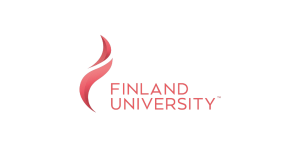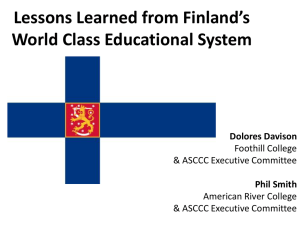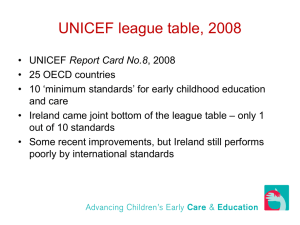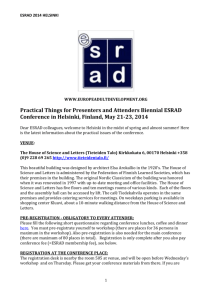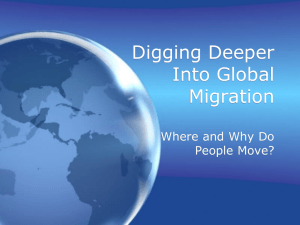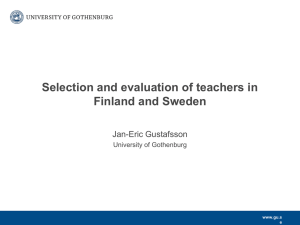Skilled Migrants in Finland - 16th International Metropolis Conference
advertisement
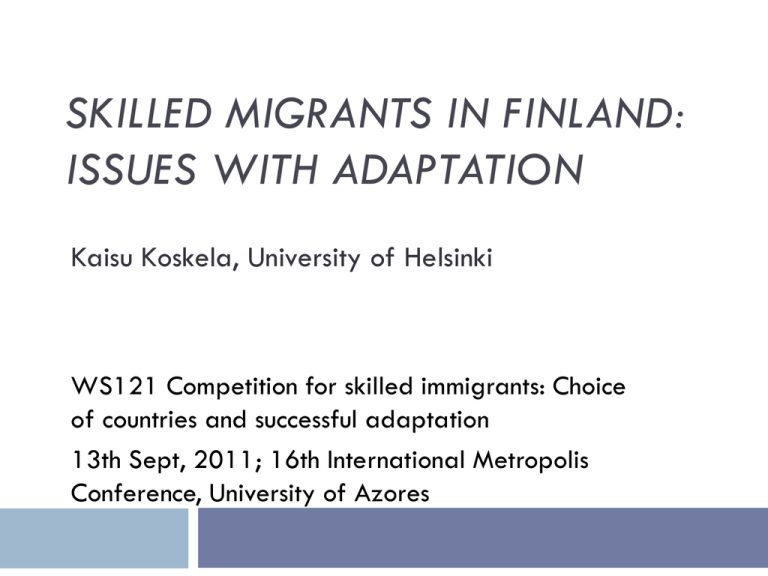
SKILLED MIGRANTS IN FINLAND: ISSUES WITH ADAPTATION Kaisu Koskela, University of Helsinki WS121 Competition for skilled immigrants: Choice of countries and successful adaptation 13th Sept, 2011; 16th International Metropolis Conference, University of Azores Migration to Finland New country of immigration (since 1990’s) 2010: 170 000 immigrants (people of foreign nationalities), less than 3% of the population Mainly humanitarian reasons: marriage-migrants, family reunifications, ethnic return migration Labour migration estimated at only 10% (Forsander et al, 2008) Skilled migrants in Finland Early 1990’s: rapid development of internet and communication technologies 1995: Finland joins EU opening borders for workers from other EU nations Actually suffers from brain drain Worries for labour shortages and the support ratio Government criticised for restrictive labour policies and lack of effort in attracting skilled migrants Very little research on skilled migrants, especially when it comes to integration/adaptation Finland in the global field of choices Considered distant (geographically and culturally), expensive, unfamiliar and cold Restrictive and late migration and labour policies little known even as a viable option Little attraction at managerial level (1,3% of nonnationals) (Auriol and Sexton, 2002). Reasons for coming to Finland: ’Global nomads’, ’quality-of-life migrants’, and migrating for social reasons The good relaxed, non-hierarchical work culture (that respects the individual) family orientation (both of society and the work place) well-functioning, hightech society trust-worthy and secure society, officials, and people small town environment Raunio, 2003 The bad low level of salaries and high level of taxes limited career advancement for oneself and poor employment opportunities for spouses difficulty in forming social relationships (both at work and free time) Climate and distance Small size of the country/ cities Issues with adaptation Finland as: ‘humane alternative to Silicon Valley‘ or ’Arctic tax-hell’? Although decisions to come to Finland are often made according to economic and career related considerations, the decision to stay is largely influenced by social factors Finland becomes a transitional place due to unsuccesful social adaptation research and policies needed specifically for the social side of skilled migrants’ experiences in Finland Further issues from my own data Skilled migrants feel well-regarded in Finland, but categorised as one homogenous group of foreigners (better than other migrants, but never at par with Finns) Cannot integrate, even if they wanted to (expected to retain their own ’positive’ cultural traits) Being a skilled migrant, and all the positive things associated with it, can be overshadowed by having an ethnicity lower down in the (Finns’) ethnic hierarchy References Auriol, Laudeline & J.Sexton (2002): Human resources in science and technology: Measurement issues and international mobility, International mobility of highly skilled, OECD proceedings, Paris Forsander, Annika (2003): Insiders or outsiders within? Immigrants in the Finnish labour market, in Söderling, Ismo (ed.) Yearbook of population research in Finland, Helsinki, The population research institute Forsander, Annika [et al] (2008): Economy, Ethnicity and International Migration. The Comparison of Finland, Hungary and Russia, in Söderling, Ismo (ed.) Yearbook of population research in Finland, Helsinki, The population research institute Kepsu, Kaisa [et al] (2009): Helsinki: An attractive metropolitan region for creative knowledge workers? The view of transnational migrants, Amsterdam, Amsterdam institute for Metropolitan and International Development Studies, (ACRE report WP7.5), http://acre.socsci.uva.nl/results/documents/7.5helsinki_FINAL.pdf Koskela, Kaisu (2010): ‘New explorations in Finnish migration studies: the emerging case of the skilled migrants', e-Migrinter 5/2010, www.mshs.univ-poitiers.fr/migrinter/index.php?text=e-migrinter/05sommaire2010&lang=frMIGRINTER Raunio, Mika (2003): Should I Stay or Should I Go?, The images and realities of foreign top professionals in Finnish working and urban environment: English Summary, Sente–working papers 6, www.sjoki.uta.fi/sente/linkkikirjasto Raunio, Mika ; Sotarauta, Markku (2005): Highly Skilled Labor Force in the Global Field of Choices: Case Finland, http://www.uta.fi/~atmaso/verkkokirjasto/Raunio%20&%20Sotarauta_Highly%20Skilled%20Finland.pdf Trux, Marja-Liisa (2002): Diversity under the Northern Star, in Forsander, Annika (ed.) Immigration and Economy in the Globalization Process: The Case of Finland, Helsinki, Sitra (Reports series, n°20) Events/associations for social integration of skilled migrants: http://www.welcomeweeks.fi/ http://www.eva.fi/en/tapahtumat/eva-expat-forum-2/679/ http://www.jollydragon.net/ Thank you for your attention! Kaisu Koskela M.Sc. Doctoral candidate University of Helsinki, Department of Sociology kaisu.koskela@helsinki.fi http://helsinki.academia.edu/KaisuKoskela

